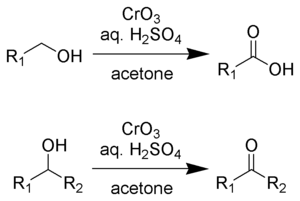Jones oxidation
| Jones oxidation | |
|---|---|
| Named after | Ewart Jones |
| Reaction type | Organic redox reaction |
| Identifiers | |
| Organic Chemistry Portal | jones-oxidation |
| RSC ontology ID | RXNO:0000356 |
The Jones oxidation is an organic reaction for the oxidation of primary and secondary alcohols to carboxylic acids and ketones, respectively. It is named after its discoverer, Sir Ewart Jones.[1]

Jones reagent consists of chromium trioxide and sulfuric acid dissolved in a mixture of acetone and water. As an alternative, potassium dichromate can be used in place of chromium trioxide. The oxidation is very rapid, quite exothermic, and the yields are typically high. The reagent rarely oxidizes unsaturated bonds.
Stoichiometry
Jones reagent will convert primary and secondary alcohols to aldehydes and ketones, respectively. Depending on the reaction conditions, the aldehydes may then be converted to carboxylic acids. For oxidations to the aldehydes and ketones, two equivalents of chromic acid oxidize three equivalents of the alcohol:
- 2 HCrO4− + 3 RR'C(OH)H + 8 H+ + 4 H2O → 2 [Cr(H2O)6]3+ + 3 RR'CO
For oxidation of primary alcohols to carboxylic acids, one equivalent of Jones reagent is required for each substrate. The aldehyde is an intermediate.
- 4 HCrO4− + 3 RCH2OH + 16 H+ + 11 H2O → 4 [Cr(H2O)6]3+ + 3 RCOOH
The inorganic products are green, characteristic of chromium(III) aquo complexes.[2]
Mechanism
Like many other oxidations of alcohols by metal oxides, the reaction proceeds via the formation of a mixed chromate ester:[3][4] These esters have the formula CrO3(OCH2R)−
- CrO3(OH)− + RCH2OH → CrO3(OCH2R)− + H2O
Like conventional esters, the formation of this chromate ester is accelerated by the acid. These esters can be isolated when the alcohol is tertiary because these lack the α hydrogen that would be lost to form the carbonyl. For example, using tert-butyl alcohol, one can isolate tert-butyl chromate ((CH3)3CO)2CrO2), which is itself a good oxidant.[5]
For those structures where there is a hydrogen atom on the carbon adjacent to the oxygen, the chromate esters degrade, releasing the carbonyl product and an ill-defined Cr(IV) product:
- CrO3(OCH2R)− → "CrO2OH−" + O=CHR
The partially deuterated alcohols HOCD2R oxidize about six times slower than the undeuterated derivatives. This large kinetic isotope effect shows that the C–H (or C–D) bond breaks in the rate-determining step. The reaction stoichiometry implicates the Cr(IV) species "CrO2OH−", which comproportionates with the chromic acid to give a Cr(V) oxide, which also functions as an oxidant for the alcohol.[6]
The oxidation of the aldehydes is proposed to proceed via the formation of hemiacetal-like intermediates, which arise from the addition of the O3CrO-H− bond across the C=O bond.
Illustrative reactions and applications
Although useful reagent for some applications, due to the carcinogenic nature of chromium(VI), the Jones oxidation has slowly been replaced by other oxidation methods. It remains useful in organic synthesis.[2][7] A variety of spectroscopic techniques, including IR can be used to monitor the progress of a Jones oxidation reaction and confirm the presence of the oxidized product. At one time the Jones oxidation was used in primitive breathalyzers.[8] Aminoindans, which are of pharmalogical interest, are prepared by the oxidation of the alcohol to ketone which is converted into an amino group. The alcohol is oxidized to the ketone with the Jones reagent. The reagent was once used to prepare salicylic acid, a precursor to aspirin.[9] Methcathinone is a psychoactive stimulant that is sometimes used as an addictive recreational drug. It can be oxidized from certain alcohols using the Jones reagent.[10]
Related processes
Several other chromium compounds are used for the oxidation of alcohols.[3] These include Collins reagent and pyridinium chlorochromate.
The Sarett oxidation is a similar process.
References
- ↑ Bowden, K.; Heilbron, I. M.; Jones, E. R. H (1946). "13. Researches on acetylenic compounds. Part I. The preparation of acetylenic ketones by oxidation of acetylenic carbinols and glycols". J. Chem. Soc.: 39. doi:10.1039/jr9460000039.
- 1 2 E. J. Eisenbraun (1973). "Cyclooctanone". Organic Syntheses. ; Collective Volume, 5, p. 310
- 1 2 Smith, Michael B.; March, Jerry (2007), Advanced Organic Chemistry: Reactions, Mechanisms, and Structure (6th ed.), New York: Wiley-Interscience, ISBN 0-471-72091-7
- ↑ Ley, S. V.; Madin, A. (1991). B. M. Trost; I. Fleming, eds. Comprehensive organic synthesis. 7. Oxford: Pergamon Press. pp. 253–256.
- ↑ Fillmore Freeman, "Di-tert-butyl Chromate" Encyclopedia of Reagents for Organic Synthesis, 2001, John Wiley & Sons, Ltd. doi:10.1002/047084289X.rd059m
- ↑ Oxidation in Organic Chemistry. Edited by K. B. Wiberg, Academic Press, NY, 1965.
- ↑ J. Meinwald, J. Crandall, and W. E. Hymans (1973). "Nortricyclanone". Organic Syntheses. ; Collective Volume, 5, p. 866
- ↑ Freudenrich, Craig. "How Breathalyzers Work". How Stuff Works. Retrieved April 2011. Check date values in:
|accessdate=(help) - ↑ Alcohol Unknown (NMR)/Synthesis of Aspirin
- ↑ Solomons, E.; Sam, J. (1973). "2-Aminoindans of pharmacological interest". Journal of Medicinal Chemistry. 16 (12): 1330–1333. doi:10.1021/jm00270a004. PMID 4765859.
Historical references
- Heilbron, I.M.; Jones, E.R.H.; Sondheimer, F (1949). "129. Researches on acetylenic compounds. Part XV. The oxidation of primary acetylenic carbinols and glycols". J. Chem. Soc.: 604. doi:10.1039/jr9490000604.
- Bladon, P; Fabian, Joyce M.; Henbest, H. B.; Koch, H. P.; Wood, Geoffrey W. (1951). "532. Studies in the sterol group. Part LII. Infra-red absorption of nuclear tri- and tetra-substituted ethylenic centres". J. Chem. Soc.: 2402. doi:10.1039/jr9510002402.
- Jones, E. R. H (1953). "92. The chemistry of the triterpenes. Part XIII. The further characterisation of polyporenic acid A". J. Chem. Soc.: 457. doi:10.1039/jr9530000457.
- Jones, E. R. H (1953). "520. The chemistry of the triterpenes and related compounds. Part XVIII. Elucidation of the structure of polyporenic acid C". J. Chem. Soc.: 2548. doi:10.1039/jr9530002548.
- Jones, E. R. H (1953). "599. The chemistry of the triterpenes and related compounds. Part XIX. Further evidence concerning the structure of polyporenic acid A". J. Chem. Soc.: 3019. doi:10.1039/jr9530003019.
- C. Djerassi, R. Engle and A. Bowers (1956). "Notes – The Direct Conversion of Steroidal Δ5-3β-Alcohols to Δ5- and Δ4-3-Ketones". J. Org. Chem. 21 (12): 1547–1549. doi:10.1021/jo01118a627.